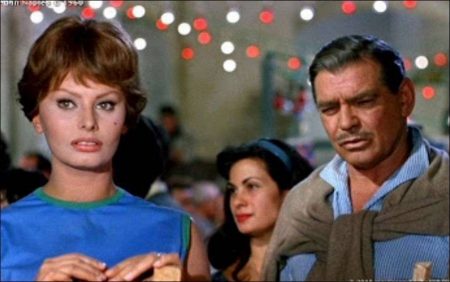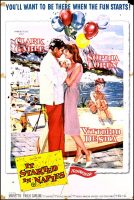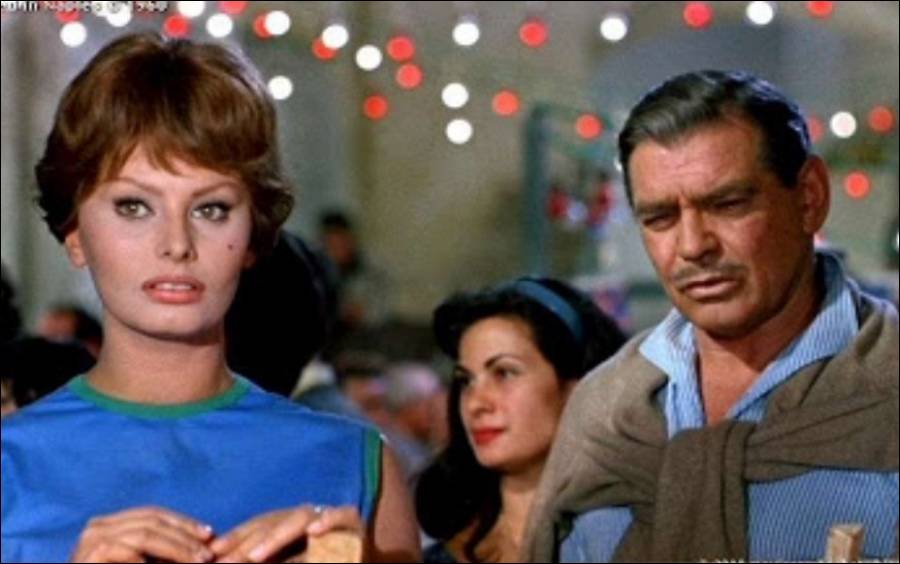It Started in Naples movie storyline. Mike Hamilton (Clark Gable), a Philadelphia lawyer, comes to Naples to settle the estate of his long estranged “black sheep” brother. Once there, he discovers that the deceased has left an eight-year old little boy named Nando, who is being raised by Michael’s sister-in-law Lucia Curcio (Sophia Loren). Mike immediately disapproves of Nando’s Italian-style (in other words “lax”) education. To make matters worse, Lucia happens to be… a sexy nightclub dancer. This is too much for a puritan like Mike and the only solution in his eyes is to have the boy brought up in the States.
It Started in Naples is a 1960 American romantic comedy film directed by Melville Shavelson and produced by Jack Rose from a screenplay by Suso Cecchi d’Amico based on the story by Michael Pertwee and Jack Davies. The Technicolor cinematography was by Robert Surtees. The film stars Clark Gable, Sophia Loren, Vittorio De Sica and an Italian cast. The film was released by Paramount Pictures on August 7, 1960.
It marked the final film to be released within Gable’s lifetime and it was his last film in color. One of the film highlights contained a tongue-in-cheek musical number by Loren called “Tu vuò fà l’americano” (You Want to Be American) written by famed Neapolitan composer Renato Carosone. Filmed on location in Rome, Naples and Capri, It Started in Naples was nominated for an Oscar for its art direction (Hal Pereira, Roland Anderson, Samuel M. Comer, Arrigo Breschi). It was released to DVD in North America in 2005.
Naples: City of love and longing
It Started In Naples (1960), starring Clark Gable and Sophia Loren, opens with a helicopter shot of the Bay of Naples and Vesuvius. Arriving at the Hotel San Francesco al Monte, a converted monastery on a mountain in the heart of the city, is also like entering a film. Whether you’re leaning on the balcony of your room (a monk’s cell, once upon a time), or eating in the stylish terracerestaurant, or lounging in the rooftop garden, there’s the same long view, the same dazzle and shimmer. Now imagine a soundtrack of campanile bells, impassioned shouts and honking horns – not to mention “the sound of the wind and the roll of the waves”, as Loren puts it in her role as nightclub singer Lucia Curcio.
The older, greyer Gable plays Mike Hamilton, an attorney from Philadelphia, who is visiting Naples to sort out the estate of his philandering brother, following his death in a boating accident. Mike is eager to conduct his business and leave “without drinking the water”; besides, his fiancee is waiting back home. He is met at the train station by his brother’s lawyer, Mario Vitale (Vittorio De Sica, the Italian director), who escorts him to his sardine can of a car, prompting a characteristic smirk from Gable, “Do we just get in or do they pack us in olive oil?” Such rearranged cliches are littered throughout the film to raise a smile, but there’s never much doubt that Neopolitan life will seduce Mike by the end. Just as it did me, on my first visit to the city.
Crowds flock around the car like crazed Beatles fans as Mario and Mike drive through the narrow streets of the historic centre during the Madonna di Piedigrotta parade, a September festival which has been raging off and on since the 16th century. Mike sees something ordinary-and-magical round every curve: a bustling piazza, a teeming vegetable stand, a curtain of laundry, a stall laden with fish, a sleeping dog, an old man squeezing his accordion. But nothing compares to the beauty of Lucia (who, as it turns out, is the sister-in-law of his deceased brother) descending from her float as the Queen of Aragon. Bellissima! Their eyes meet and the earth rocks: perhaps it is love at first sight; if not, the rumbling bowels of the city’s underworld with its caves and catacombs, or just the onslaught of revellers and scooters.
This area has the same allure today, and I reached it easily by catching the funicular near the convent-hotel, then burrowing downhill and emerging in a treasure-trove: the theatre of San Carlo; Castel Nuovo; Palazzo Reale; San Francesco de Paola; not to mention Caffé Gambrinus, a lively espresso stop and one of Oscar Wilde’s old hangouts. I strolled from one to the other (though a taxi ride can be equally thrilling), surrounded on every side by Roman foundations and crumbling Greek arches, dignified Gothic churches and massively rusticated baroque facades. And the highlight? A prowl down Spaccanapoli, and then on to Via Tribunali, with its Norman fortress and 13th-century cathedral.
Just six years before It Started In Naples, Loren made a memorable sashay down these same streets as a pizza seller and wayward wife in L’Oro Di Napoli, The Gold Of Naples (this time directed by Vittorio De Sica). The same staple of Neopolitan cuisine is still everywhere; look for a raised golden crust, a soft doughy pastry and just few toppings – mozzarella, tomato and basil. They’re served in any of the sidewalk pizzerias along Via Partenope, where one can see the old castle brooding over the harbour, and the locals sunbathing on the rocks like awkward seals, or fishing for delights you’ll later find on your dinner plate.
A wonderful family-run fish restaurant is nearby at Ristorante Dora (Via Ferdinando Palasciano, 30) – I recommend the linguine with crustaceans, which the hospitable waiters serve with one hand while offering a bib with the other. More mouth-watering fun is at Trattoria da Cicciotto along the bay in Posillipo (Calata Ponticello a Marechiaro, 32), well-worth the half-hour drive, and not just for the fabulous sea view: the fish is so fresh they don’t offer a menu. Since the restaurant was founded in 1942, it has been frequented by film stars – as the wall-photos prove. If Gable didn’t stop here during his time off from shooting, he missed a trick.
In It Started In Naples, Mike follows Lucia to Capri, and discovers that his brother and his Italian wife, who also died in the accident, left behind a 10-year-old son, Nando (Marietto). Lucia has claimed the orphan as her own, even though she’s not able to give much of a watchful eye, thanks to the time she spends dancing the tarantella in the local club. Mike objects to this – but as the battle for custody unrolls, and with delightful predictability, romantic sparks start to fly. Nando’s pretty winning, too: a typically adorable scugnizzo. These “street urchins” still haunt Naples, hustling small jobs, selling cigarettes in cafes, washing windshields at stoplights.
At the end of the film, Mike wins custody of Nando, but when they get to the train station to return to America, he has a change of heart and sends him back to Lucia. Then he boards the train alone, and just when it’s about to depart… Well, it’s a very Hollywood ending, but nothing could be more appropriate in the city of love and longing.
It Started in Naples (1960)
Directed by: Melville Shavelson
Starring: Clark Gable, Sophia Loren, Vittorio De Sica, Marietto, Paolo Carlini, Giovanni Filidoro, Claudio Ermelli, Bob Cunningham, Marco Tulli, Carlo Rizzo, Yvonne Monlaur
Screenplay by: Suso Cecchi d’Amico
Cinematography by: Robert Surtees
Film Editing by: Frank Bracht
Costume Design by: Orietta Nasalli-Rocca
Set Decoration by: Arrigo Breschi, Sam Comer
Art Direction by: Roland Anderson, Hal Pereira
Music by: Alessandro Cicognini, Carlo Savina
MPAA Rating: None.
Distributed by: Paramount Pictures
Release Date: August 7, 1960
Views: 255





